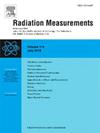利用掺铈SrHfO3闪烁体评价硅光电倍增管光子计数CT的光子计数能力
IF 2.2
3区 物理与天体物理
Q2 NUCLEAR SCIENCE & TECHNOLOGY
引用次数: 0
摘要
采用用于医学应用的光子计数计算机断层扫描(PCCT)获得横截面图像,其中包括硅光电倍增管(SiPM)和Ce, Mg和Al共掺杂的SrHfO3透明陶瓷闪烁体(Mg/Al/Ce:SHO)。我们的PCCT系统配备了该闪烁体,最大计数率达到8 MHz。提高最大计数率对短时成像至关重要,进一步提高计数能力对临床应用至关重要。与早期PCCT系统中使用的Ce:(Y, Gd)3(Al, Ga)5O12闪烁体相比,Mg/Al/Ce:SHO闪烁体具有更短的衰减时间(~ 20 ns)和更高的密度(7.6 g/cm3),并通过火花等离子烧结制备并集成到PCCT中。通过使用x射线管改变入射x射线光子的强度并应用非瘫痪死区时间模型来估计最大计数率,产生大约8 mhz的光子计数能力,是我们之前系统的两倍。此外,在0.5、1.0和2.0 mA的x射线管电流下,使用碘和钆造影剂进行静态幻像成像。增大管电流后,图像质量在CT值的标准差范围内保持一致。这些发现表明,与传统系统相比,Mg/Al/Ce:SHO闪烁体在临床PCCT应用中具有更大的潜力。本文章由计算机程序翻译,如有差异,请以英文原文为准。
Evaluation of photon-counting capability for silicon photomultiplier-based photon-counting CT using Ce-doped SrHfO3 scintillator
Cross-sectional images were obtained using photon-counting computed tomography (PCCT) for medical applications, incorporating a silicon photomultiplier (SiPM) and Ce-, Mg- and Al-codoped SrHfO3 transparent-ceramic scintillator (Mg/Al/Ce:SHO). A maximum counting rate of 8 MHz was achieved with our PCCT system equipped with this scintillator. Enhancing the maximum counting rate is crucial for short-time imaging, and further advancements in counting capability are essential for clinical applications. The Mg/Al/Ce:SHO scintillator, which has a shorter decay time (20 ns) and higher density (7.6 g/cm3) compared to the Ce:(Y, Gd)3(Al, Ga)5O12 scintillator used in earlier PCCT systems, was prepared via spark plasma sintering and integrated into the PCCT. The maximum counting rate was estimated by varying the intensity of incident X-ray photons using an X-ray tube and applying a non-paralyzable dead-time model, yielding approximately 8 MHz–double the photon-counting capability of our previous system. Additionally, static phantom imaging with iodine and gadolinium contrast agents was performed at X-ray tube current of 0.5, 1.0 and 2.0 mA. The image quality remained consistent within the standard deviation of CT values despite increasing the tube current. These findings suggest that the Mg/Al/Ce:SHO scintillator offers superior potential for clinical PCCT applications compared to conventional systems.
求助全文
通过发布文献求助,成功后即可免费获取论文全文。
去求助
来源期刊

Radiation Measurements
工程技术-核科学技术
CiteScore
4.10
自引率
20.00%
发文量
116
审稿时长
48 days
期刊介绍:
The journal seeks to publish papers that present advances in the following areas: spontaneous and stimulated luminescence (including scintillating materials, thermoluminescence, and optically stimulated luminescence); electron spin resonance of natural and synthetic materials; the physics, design and performance of radiation measurements (including computational modelling such as electronic transport simulations); the novel basic aspects of radiation measurement in medical physics. Studies of energy-transfer phenomena, track physics and microdosimetry are also of interest to the journal.
Applications relevant to the journal, particularly where they present novel detection techniques, novel analytical approaches or novel materials, include: personal dosimetry (including dosimetric quantities, active/electronic and passive monitoring techniques for photon, neutron and charged-particle exposures); environmental dosimetry (including methodological advances and predictive models related to radon, but generally excluding local survey results of radon where the main aim is to establish the radiation risk to populations); cosmic and high-energy radiation measurements (including dosimetry, space radiation effects, and single event upsets); dosimetry-based archaeological and Quaternary dating; dosimetry-based approaches to thermochronometry; accident and retrospective dosimetry (including activation detectors), and dosimetry and measurements related to medical applications.
 求助内容:
求助内容: 应助结果提醒方式:
应助结果提醒方式:


